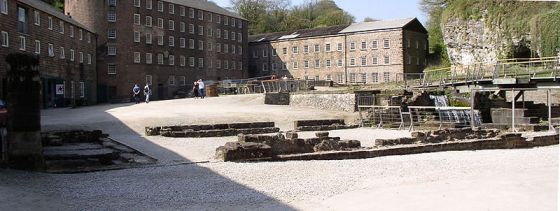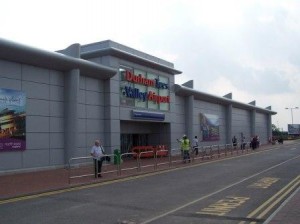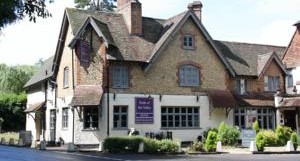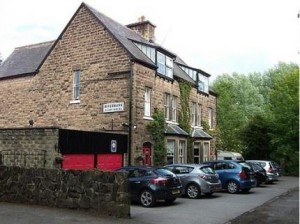
Cromford Mill, Derwent Valley Mills
Derwent Valley Mills are located along the River Derwent in Derbyshire in central England. The site is of both historical and technological interest and significance, it is seen as the birthplace of the factory system that would become widely used across the world. The site attained World Heritage Site status in 2001 in recognition of the significance of the site, the WHS status has helped to raise the profile of the site and ensure there are plans to protect and preserve the site for the future. The site along the River Derwent offers visitors the chance to see a number of different sites along the route and enjoy an educational day out.
Overview
Derwent Valley Mills located in Derbyshire contains a number of cotton mills dating back to the 18th and 19th centuries, the mills and the surrounding landscape that includes workers living facilities form the basis of the designated World Heritage Site (WHS). The site is about 15 miles in length along the river starting from Matlock Bath all the way to Derby. Along the route there are a number of mills and complexes for visitors to see that are steeped in history and offer a fascinating insight in to the past. It was here in the mills and the complexes back in the 18th century that water power was originally used to help with textile production. This was a significant discovery as it helped to change textile production as never before, the model became known as the Arkwright model helped many developments and advances in countries across the world.
The Derwent Valley Mills site also contains the housing for the workers that once worked in the mills and factories, the rural setting made this a necessity. Along with the housing facilities came the creation of the first industrial towns in a modern context. The houses and buildings that were used at the time are still there having survived the test of time surprisingly well. There are ten key sites that make is the main site here, among them are:
Masson Mills first started back in 1783 and was built to offer a great power source than earlier mills such as that at Cromford. The mill is constructed in brick and was originally a five storey building, over the years there have been extensions and alterations to the building including changes in to the 20th century. The Masson Mill has undergone a major restoration and repair and is currently a textile museum and a retail village.
Cromford Mill is well known as the world's first water powered cotton spinning mill. Building began back in 1771 and was completed in 1790. The complex includes a number of linked mills, workshops and warehouses, in the 1970s it was saved from being left derelict and is in the process of an extensive and complex restoration. Currently there is an exhibition for visitors to learn more about the complex along with a restaurants and gift shop.
Willersley Castle was built for Sir Richard Arkwright who had created the new technology used for spinning cotton. Sir Richard never actually lived in the castle, set in parkland, it provides wonderful views of the Derwent Valley, and the castle retains much of the original features such as the Well Gallery and the Glass Dome.
St Mary's Church is the parish church for Comford and was first opened in 1797, the church was extensively altered and had gothic elements added in 1858, it contains a large collection of mural decorations and a memorial to Mrs Arkwright. There are also a number of paintings and stained glass for visitors to see.
Cromford is the village that was built for the workforce of Sir Richard Arkwright that worked in the mills and complexes here. The village is still largely intact, notably places include the Market Place that was at the centre of the community here, it was built in approx 1790, the Arkwright Stores built in the approx 1780 and the Greyhound Hotel built in 1778 are all still here for visitors to see. The first workers housing and the village lock-up in Swift's Hollow are also still here. A quick tour here provides visitors with a valuable insight in to what is was like to live and work here.
Cromford Canal was built at the end of the 18th century and runs for approx 23km starting from Cromford and going to the Erewash Canal. The aim of the canal was to use the great mineral wealth known to exist in the area. From the Cromford end of the canal there is the Cromford Canal Wharf that contains the Counting House and canal cottages dating back to the end of the 18th century.
John Smedley's Mill is located at Lea Bridge, here the factory has produced textiles for over 200 years and continues to do so today. The factory is still in operation and produces some of the best knitwear visitors will find. The factory shop is open from 10.00 to 16.00 on a daily basis and offers the chance for visitors to see an actual mill in action.
Belper River Gardens are situated on the river Derwent and offer a contrast to the other areas, visitors can enjoy some peace and quiet here as well as enjoying the relaxing scenery. In the summer the gardens are used to host theatre performances and concerts.
Strutt's North Mill was built in 1786 and then destroyed by fire in 1803, the building that replaced it was seen as technologically advanced for its time, incorporating fire proof structures and is the second oldest fire proof iron framed building in the world, it is seen as a blueprint for the large steel framed structures of today.
The town of Belper contains the old cottages of the mill workers and the St John's Chapel now the Belper Heritage Centre. Visitors can walk on the streets of the factory community made by the Strutt family for their mill workers, created back in the 1780's.
Milford
The Silk Mill contains the Derby Industrial Museum, the historic building was built from 1717 to 1721 and represents a landmark building during both the Industrial Revolution and the growing development of the textile industry in the UK at the time. The museum contains further information on the importance of Derby in the railway industry. The Silk Mill is viewed as the first modern factory and the museum contains a range of exhibits to this and other areas of industry.
How To Get There
The World Heritage Site at Derwent Valley is located in Derbyshire, Central England, it is accessible by car and public transport:
By Car:
If travelling from the M1 Motorway, take the M1 up to junction 28. Exit the M1 at junction 28 and take the A38, drive until you see an exit for the A610 at a roundabout and take the A610 drive until you see Ambergate Train Station at the junction of the A610 and the A6. From the A6 both ways contain sites on the World Heritage Site along the River Derwent.
From the A6 from Matlock Derwent to Derby (and vice versa) the WHS are located along the River Derwent.
By Train:
There are national rail services visitors can use to see the area. On the Matlock Derwent Valley Line offers services from London St Pancreas station to Derby and Belper, Ambergate, Whatstandwell, Cromford, Matlock Bath and Matlock (along the World Heritage Site route).
Train services are approx 2 & 1/2 hours to the World Heritage Site from London.
By Bus:
Trent Barton bus services offer local bus services in the area and local vicinity. The route numbers, 6.1, 6.2, 6.3 and 6.4 take you from Derby to Belpher. Service is every 15 minutes from Mon to Sat and hourly on Sun.
There are bus services from the Transpeak route that takes passengers from Derby along the World Heritage Site and up to Matlock and beyond. Service is hourly.
Contact Details
Address:
Derwent Valley Visitor Centre
North Mill
Bridgefoot
Belper
Derbyshire
DE56 1YD
United Kingdom
Telephone: +44 (0)1773 880474
Website: Derwent Valley World Heritage Site
Facilities and Information
Further Information:
Masson Mills:
Opening Times:
Mon to Fri: 10.00 to 16.00, Sat: 11.00 to 17.00, Sun: 11.00 to 16.00
Admission: Adults: £2.50 approx, Children: £1.50 approx, Concessions: £2.00 approx and Family Ticket: £6.50 approx
Cromford Mill:
Opening Times:
Mon to Sun: 09.00 to 17.00
Admission Free: Guides Tours are Adults: £2.00 approx, Children: £1.50 approx and Concessions: £1.50 approx
Willersley Castle:
Opening Times:
Mon to Sun: 09.30 to 18.00
Admission Free
John Smedley's Mill:
Opening Times:
Mon to Sun: 10.00 to 16.00
Admission Free
Stutt's North Mill:
Opening Times:
Summer: Wed to Sun: 13.00 to 17.00, Winter: Sat & Sun Only: 13.00 to 17.00
Admission: Adults: £3.00 approx, Children: £2.00 approx, Concessions: £2.50 approx and Family Ticket: £8.50 approx
The Silk Mill:
Opening Times:
Mon: 11.00 to 17.00, Tues to Sat: 10.00 to 17.00, Sun: 13.00 to 16.00
Admission Free
Map
View Larger Map
For Local Search and Directions see: Derwent Valley Mills Map
Tips & Other Considerations
There may be some variations on the opening hours of the various visitor attractions at the Derwent Valley site, depending on the time of year and other factors. Visitors are advised to double check each attraction they wish to see before going & avoid disappointment.
When travelling always remain alert and aware of your surroundings and environment and follow travel safety tips. Ensure your belongings in particular your wallet/purse and valuables are hidden away from public view (especially at tourist attractions & places with crowds). If you have a bag try to use a shoulder bag with a good quality, strong strap, that is put across your shoulder not on your shoulder making it more difficult for anyone to take your bag.
If you are travelling by car to the Derwent site, ensure you are well prepared with maps and Sat Nav to aid your journey, particularly if you are not familiar with the local area and roads. It is recommended drivers exercise caution and drive safely. Use the Route Planning tool for door to door directions for car and public transport journeys
If you are looking for local car parking along the Derwent Valley site and the WHS, ensure you fully understand the rules, regulations & charges for car parks and street parking before you park your car. The rules & regulations can be complex if you are not sure it is wise not to park there.
If you are travelling by public transport, check for service updates prior to beginning your journey for any delays, disruption or cancellations to services that may impact on your journey. Ensure you have the service timetables for the trains, buses and coaches. Remember when the last services are and ensure you make it to the train/bus/coach stops well in time to avoid missing the service.
Disclaimer: The information given in on this website is given in good faith and to the best of our knowledge. If there are any discrepancies in no way do we intend to mislead. Important travel details and arrangements should be confirmed and verified with the relevant authorities.




